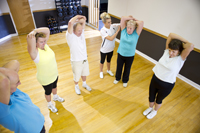Amy Colcher, MD
Director, Movement Disorders Center
 Parkinson’s disease (PD) is a neurodegenerative condition that leaves people feeling stiff and slow, and often affects posture and balance. Neurologists diagnose and treat PD, while patients look for medications to alter the course of the disease or help with symptoms. What many patients fail to recognize is that exercise is a crucial part of the management of PD.
Parkinson’s disease (PD) is a neurodegenerative condition that leaves people feeling stiff and slow, and often affects posture and balance. Neurologists diagnose and treat PD, while patients look for medications to alter the course of the disease or help with symptoms. What many patients fail to recognize is that exercise is a crucial part of the management of PD.
There have been numerous studies clarifying the ways in which exercise helps. “BIG Therapy” is a specialized physical therapy program for PD – encouraging high amplitude, or big movements. The goal of BIG Therapy is to change the way people with Parkinson’s perceive movement. Because of the stiffness and slowness associated with PD, patients think that they are moving normally when they apply the same amount of effort as they did before they had PD. But, to an observer, their movements look slow and diminished. Resetting the patient’s perception of what normal feels like allows them to move in a way that looks normal. Patient’s stand up straighter, take longer strides and swing their arms better when they walk. All of this results in improved endurance, stamina and decreased falls.
Certain kinds of exercise influence activity in the brain by changing neurotransmission. Exercise-dependent neuroplasticity is the term used for changes in the way the brain responds to neurotransmitters and the way it maintains connections and forms new ones. Studies have been done in high-intensity exercise with high-velocity activities using bodyweight-supported treadmill training, as well as the use of a Theracycle. Both of these allow the legs to move at speeds faster then they could go on their own. In the treadmill training the body is supported with a harness; the treadmill speed is increased so that the legs can move quickly (up to 8 mph) without having to support the body. The Theracycle can be adjusted so that the peddling speed is set at a fast rate and the legs go along for the ride. Both of these result in improvements in many parkinsonian symptoms.
Aerobic exercise can improve cognitive functioning, specifically frontal lobe or executive function in patients with PD. These brain functions involve planning, organizing, and setting goals and figuring out how to meet them. Twice a week, for an hour, patients did aerobic activity and resistance exercises, and gradually increased the workload at each session.
Exercise should be a part of everyone’s daily routine. Patients with PD especially should understand the beneficial effects of exercise. Finding specialists who know what kind of exercise programs to recommend will help PD patients live fuller lives.
